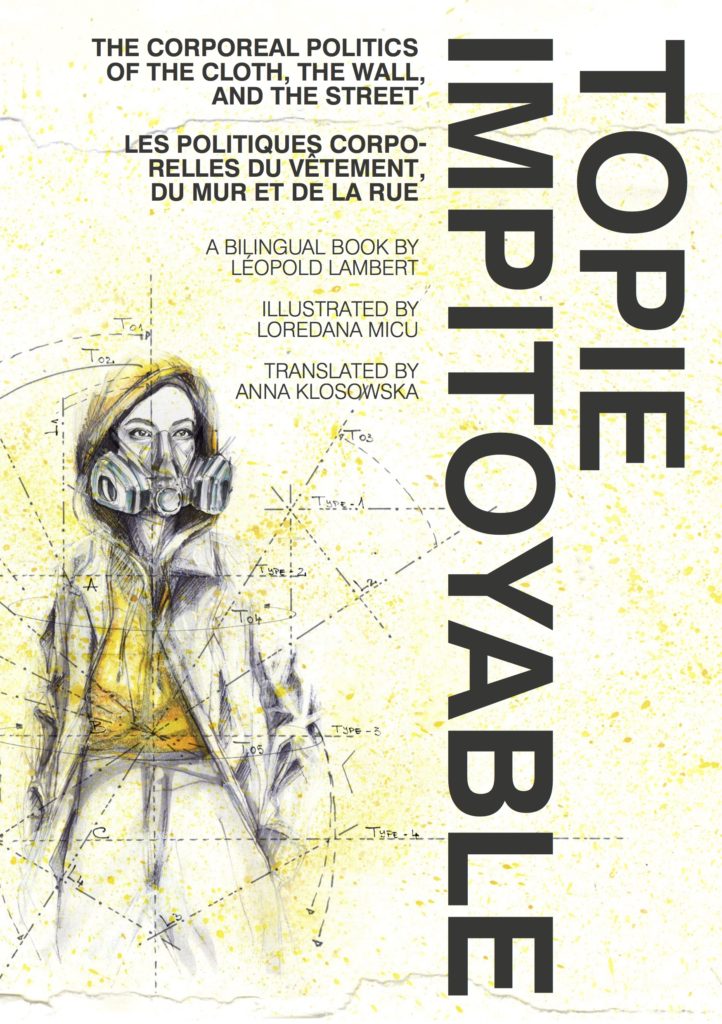This new book begins where the previous one, Weaponized Architecture: The Impossibility of Innocence, ended….That book started with the hypothesis that architecture is inherently violent because of the way it dissects space and because of the resulting spatial organization of bodies. Architecture is a social discipline, and therefore this violence always ends up as an instrument of politics, whether it’s done consciously or not. ~Léopold Lambert
Qu’est-ce qu’un corps? Ce livre s’attache d’avantage à se poser cette question qu’à y répondre. L’ouvrage propose de complexifier quelques lieux communs à diverses échelles de proximité de cet assemblage matériel qu’est le corps. Ceci permet d’intégrer pleinement les objets, atmosphères et autres corps environnant celui-ci afin de proposer une lecture politique de leurs relations volontaires et fortuites. Du sweatshirt à capuche porté par Trayvon Martin lorsqu’il se fit tuer dans la banlieue de Miami Gardens, Florida, aux rues new-yorkaises durant Occupy Wall Street, en passant par le mur d’apartheid en Palestine, ce livre progresse par une succession d’exemples illustrant l’hypothèse selon laquelle les corps et les objets de toutes tailles entretiennent nécessairement des rapports politiques entre eux.
What is a body? This book is more attached to raising the question than in offering a definitive answer. Instead, Lambert proposes to make more complex certain commonplaces located at various degrees of proximity to the body’s material assemblage, allowing a better integration of the surrounding objects, atmosphere and other bodies and proposing a political reading of their relationship to the body, whether deliberate or accidental. From the hoodie that Trayvon Martin wore when he was killed in the suburbs of Miami Gardens, Florida, to the streets of New York City during Occupy Wall Street and the apartheid wall in Palestine, this book moves through a series of episodes that illustrate how bodies and objects of all sizes are enmeshed in deeply entangled political relationships.
About the Author
 Léopold Lambert is a Paris-based architect, and also the founder and editor-in-chief of The Funambulist, a bimestrial magazine associated with a weblog and a podcast, Archipelago, that all examine the politics of the built environment in relation to the bodies. He is the author of Weaponized Architecture: The Impossibility of Innocence (dpr-barcelona, 2012) and La politique du bulldozer: La ruine palestinienne comme projet israelien (B2, 2016), as well as The Funambulist Pamphlets, vol. 1-11 (punctum books, 2013-2015). He is also the editor of The Funambulist Papers, vol. 1-2 (punctum books, 2013-2015).
Léopold Lambert is a Paris-based architect, and also the founder and editor-in-chief of The Funambulist, a bimestrial magazine associated with a weblog and a podcast, Archipelago, that all examine the politics of the built environment in relation to the bodies. He is the author of Weaponized Architecture: The Impossibility of Innocence (dpr-barcelona, 2012) and La politique du bulldozer: La ruine palestinienne comme projet israelien (B2, 2016), as well as The Funambulist Pamphlets, vol. 1-11 (punctum books, 2013-2015). He is also the editor of The Funambulist Papers, vol. 1-2 (punctum books, 2013-2015).



3 thoughts on “Topie Impitoyable: The Corporeal Politics of the Cloth, the Wall, and the Street”